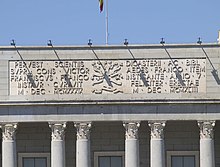Fascist architecture
| Part of a series on |
| Fascism |
|---|
 |
Fascist architecture encompasses various stylistic trends in architecture developed by architects of
Both Benito Mussolini and Adolf Hitler utilised new styles of architecture (variations of Rationalism and Stripped Classicism, respectively) as one of many attempts to unify the citizens of their states, mark a new era of nationalist culture, and exhibit the absolute rule of the state.[1]

History
The fascist styles of architecture reflect the values of
Italian and German fascism
Fascist architecture in the form of
Similarly, once Hitler came to power in 1933 and transformed the German Chancellery to a dictatorship, he used fascist architecture in the form of
Style
Fascist styles of architecture are a branch of modernist architecture which became popular in the early 20th century. The Italian Fascist style was also greatly influenced by the rationalist movement in Italy in the 1920s. Rationalist architecture, with the help of Italian government support, celebrated the new fascist age of culture and government in Italy.[8]
In Nazi Germany, the extremely large and spacious Fascist architecture was one way envisioned by Hitler to unify Germany for what he described as "mass experiences", in which thousands of citizens could gather and take part in the patriotism of community events, and listen to speeches made by Hitler and other Nazi party leaders.
The fascist styles of architecture took design cues from Ancient Rome in that buildings of the styles were generally very large and symmetric with sharp non-rounded edges. The buildings purposefully conveyed a sense of awe and intimidation through their size, and were made of limestone and other durable stones in order to last the entirety of the fascist era and create impressive ruins. The buildings were also very plain, with little or no decoration, and lacked much complexity in design. These generalities of fascist architecture contributed to the simple aesthetics the edifices display. All these aspects helped the fascist dictatorships exhibit absolute and total rule of the population. Hitler and Mussolini used fascist architecture as another source of propaganda to display to the world the strength, pride and power their regimes had.[9]
Architects
The most prominent Italian and German fascist architects of the era were:
- Giuseppe Terragni – Notable work of Terragni includes the Casa del Fascio.
- Marcello Piacentini – Notable work of Piacentini includes the fascist district EUR, Rome.
- Albert Speer – Speer was Hitler's favorite German architect. He designed the Deutsches Stadion and had plans of rebuilding Berlin, using fascist style architecture, around a massive hall called the Volkshalle.[10]
-
Casa della Parola (House of the Word), Arnaldo dell'Ira, 1940
Structures
A few of the notable fascist architecture projects of the 20th century include
- EUR, Rome (Esposizione Universale Roma) – Construction of the EUR began in 1936 in anticipation for Mussolini's World Fair in 1942 to mark the 20th anniversary of the Italian fascist era
- Palazzo della Civiltà Italiana – A famous edifice of the EUR
- Palazzo delle Poste, Palermo
- Palazzo di Giustizia, Milan
- Nazi party rally grounds
- Third Reich[11]
See also
- Brutalism
- Nazi architecture
- Monumentalism
- Novecento Italiano
References
- ^ "The Fascinating World of Fascist Architecture". Retrieved 2012-02-04.
- ^ "Fascist Architecture in Italy". Retrieved 2012-02-04.
- ^ Mathews, Jeff. "The Architecture of Fascism in Naples". Archived from the original on 2011-09-17. Retrieved 2012-02-04.
- ^ Payne, Stanley. "Italian Fascism". Archived from the original on 2012-04-01. Retrieved 2012-02-12.
- ^ Mathews, Jeff. "The Architecture of Fascism in Naples". Archived from the original on 2011-09-17. Retrieved 2012-02-12.
- ISBN 978-1009354103.
- ^ "Welthauptstadt Germania". Archived from the original on 2016-09-03. Retrieved 2012-02-12.
- JSTOR 989580.
- ^ "Order from Stone: Nazi Architecture". Archived from the original on 2014-07-24. Retrieved 2012-02-04.
- ^ Fulvio, Irace. "Piacentini". Retrieved 2012-02-13.
- ^ Piperno, Roberto. "A XXth century New Rome". Retrieved 2012-02-04.
- Fascismo - Architettura - Arte. Arte fascista web site

